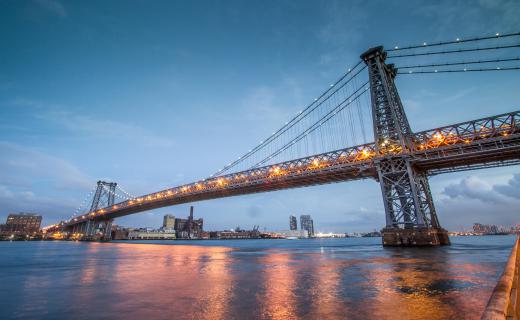What is a Suspension Bridge?
 Mary McMahon
Mary McMahon
A suspension bridge is a type of bridge which is built by suspending the roadway from cables attached to a master cable which runs above the length of the bridge. In addition to being strong and lightweight, these types of bridges are also beautiful, and some of the most famous bridges in the world are also built in this way, including San Francisco's iconic Golden Gate Bridge and New York's Brooklyn Bridge. The design of a suspension bridge is simple and straightforward, and takes advantage of several techniques to distribute the weight of the bridge safely and evenly.
The basic design of a suspension bridge has been in use for centuries: thousands of years ago, people crossed waterways and chasms by swinging hand over hand on suspended cables. Later, walkways were hung from the cables to make the process easier, and the original vines and ropes began to be replaced with chains. Major bridges were still built using a truss design until 1808, when an American inventor named James Finley filed a patent on an early version of this type of bridge. Finley's design involved stretching two strong chains over the top of several towers and anchoring them on either side of the bridge. He hung lesser chains from the two master chains and used them to suspend a rigid deck, and the modern incarnation of this bridge was born.

In 1830, French engineers realized that strongly woven cables were more safe than chains, and began to use them in the construction of suspension bridges. The bridges built today all use this cabled design, but the basic form of has remained the same, and engineers continue to push the limits of the spans that suspension bridges can cross. The world's longest one as of 2007 was the Akashi Kaiyo Bridge in Japan, with an unsupported center span of 1.2 miles (1,991 meters), and a total length of 2.4 miles (3,911 meters).

A suspension bridge starts with building the towers. If possible, the towers are located on dry land and anchored to bedrock. If the towers must be located in the water, structures called caissons are used to force water out of the area of work so that construction can be done in a dry area. Once the towers are built and anchored, the master cables are strung across them and anchored to points on dry land, although some bridges are self suspending, meaning that the master cables are actually anchored to the deck of the bridge itself. Next, suspension cables are strung from the master cables, and then the deck is attached to them.
The simple design of a suspension bridge allows for a high clearance under the deck, useful when the bridge is being built over a major shipping waterway or a very deep chasm. A bridge of this type also has slender, clean lines which are aesthetically appealing to many engineers, and is less subject to collapse than some other bridge types such as those built on support trusses. It is also flexible, making it more likely to survive earthquakes and extreme weather, although the flexibility also makes it only appropriate for vehicles and light rail: the concentrated forward weight of a heavy freight locomotive has too much energy for a suspension bridge to bear safely.
AS FEATURED ON:
AS FEATURED ON:












Discussion Comments
Suspension bridges are cool.
I am doing a school report on bridges and so far I think the suspension bridge is the most fascinating piece of artwork I have ever heard about. I have seen one in San Francisco and it was straight out amazing.
As a structural engineer I can tell you that as amazingly beautiful as suspension bridges are they are unfortunately not the best choice for stability and load bearing.
This is a real disappointment as my favorite bridge type is the suspension bridge. As we progress in technology and culture we have to make some decisions that are truly effected most of all by utilitarian intent. If that means spending less money on a more stable bridge, then suspension bridges fail the test for the project.
The first time that I ever walked across the Golden Gate Bridge in San Francisco I was a mere eight years old. The experience was breathtaking and I will never forget the scenery. You could see for miles and the bay was beautiful that day with the sun high over head.
That amazing suspension bridge peaked my interested in how the incredible land marks can be constructed. After a little research I discovered that not only these structures a monumental task to design and build but they also require a constant maintenance to ensure the safety of the travelers they suspend.
Did you know that it takes several years for the maintenance crews of the Golden Gate Bridge to paint the entire thing? When they reach one side of the bridge they turn back around and continue back the other way. This constant repainting in critical in keeping the weather off of the famous bridge.
For me, there is nothing like getting the perfect suspension bridge picture. With so many of this popular bridge construction type to choose from one can really be picky about locating and scenery that surrounds the bridge.
Framing and composition is key in photographing these bridges as with most scenery photography. The technique that you use in exposing the image will impact greatly the viewers perception as well.
Post your comments